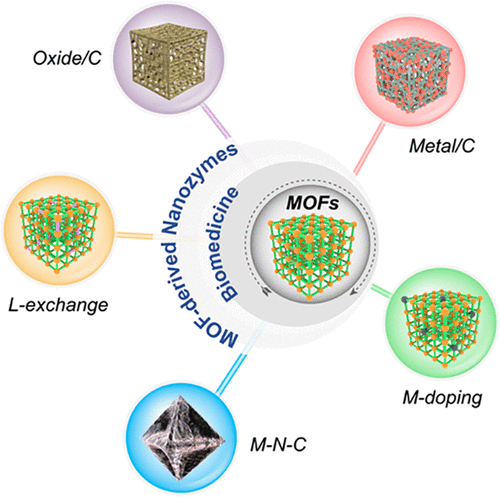当前位置:
X-MOL 学术
›
Acc. Chem. Res.
›
论文详情
Our official English website, www.x-mol.net, welcomes your
feedback! (Note: you will need to create a separate account there.)
Metal-Organic Framework Derived Nanozymes in Biomedicine.
Accounts of Chemical Research ( IF 16.4 ) Pub Date : 2020-06-29 , DOI: 10.1021/acs.accounts.0c00268 Dongdong Wang 1 , Deblin Jana 1 , Yanli Zhao 1, 2
Accounts of Chemical Research ( IF 16.4 ) Pub Date : 2020-06-29 , DOI: 10.1021/acs.accounts.0c00268 Dongdong Wang 1 , Deblin Jana 1 , Yanli Zhao 1, 2
Affiliation

|
Nanozymes, which integrate the advantages of both nanomaterials and natural enzymes, have accumulated enormous research interest over the past decades because of the opportunity they provide to appreciate and further cultivate artificial enzymes with comparable properties. By mimicking the coordination environments of the catalytic sites in natural enzymes, nanozymes with confined nanostructures can serve as substitutes in many catalytic processes with comparable activity and robust stability even in harsh conditions. Since the pioneering report about peroxidase-mimicking ferromagnetic nanoparticles in 2007, nanozymes have been developed as specialized for nanomaterials with intrinsic enzyme-mimicking property. With the rapid development in nanoscience and nanotechnology, nanomaterials with superior advantages, such as large-scale production, desired activity, and robust stability, can bridge the natural enzymes with nanozymes.
中文翻译:

生物医学中金属有机骨架衍生的纳米酶。
纳米酶结合了纳米材料和天然酶的优点,由于它们提供了欣赏和进一步培养具有可比性能的人造酶的机会,因此在过去几十年中积累了巨大的研究兴趣。通过模仿天然酶中催化位点的配位环境,具有局限性纳米结构的纳米酶可以在许多催化过程中以类似的活性和稳定的稳定性替代,即使在恶劣的条件下也是如此。自2007年关于过氧化物酶模拟铁磁性纳米颗粒的开创性报告以来,纳米酶已被开发出来,专门用于具有固有酶模拟特性的纳米材料。随着纳米科学和纳米技术的飞速发展,具有大量生产,
更新日期:2020-07-21
中文翻译:

生物医学中金属有机骨架衍生的纳米酶。
纳米酶结合了纳米材料和天然酶的优点,由于它们提供了欣赏和进一步培养具有可比性能的人造酶的机会,因此在过去几十年中积累了巨大的研究兴趣。通过模仿天然酶中催化位点的配位环境,具有局限性纳米结构的纳米酶可以在许多催化过程中以类似的活性和稳定的稳定性替代,即使在恶劣的条件下也是如此。自2007年关于过氧化物酶模拟铁磁性纳米颗粒的开创性报告以来,纳米酶已被开发出来,专门用于具有固有酶模拟特性的纳米材料。随着纳米科学和纳米技术的飞速发展,具有大量生产,











































 京公网安备 11010802027423号
京公网安备 11010802027423号